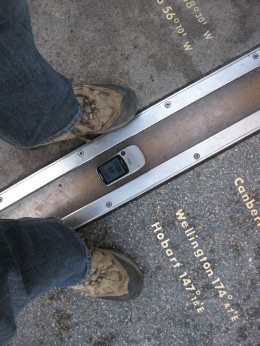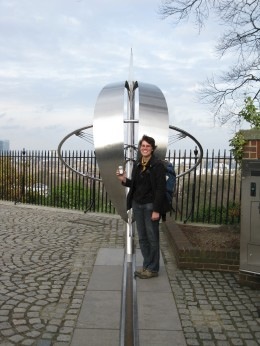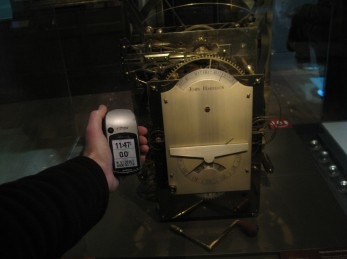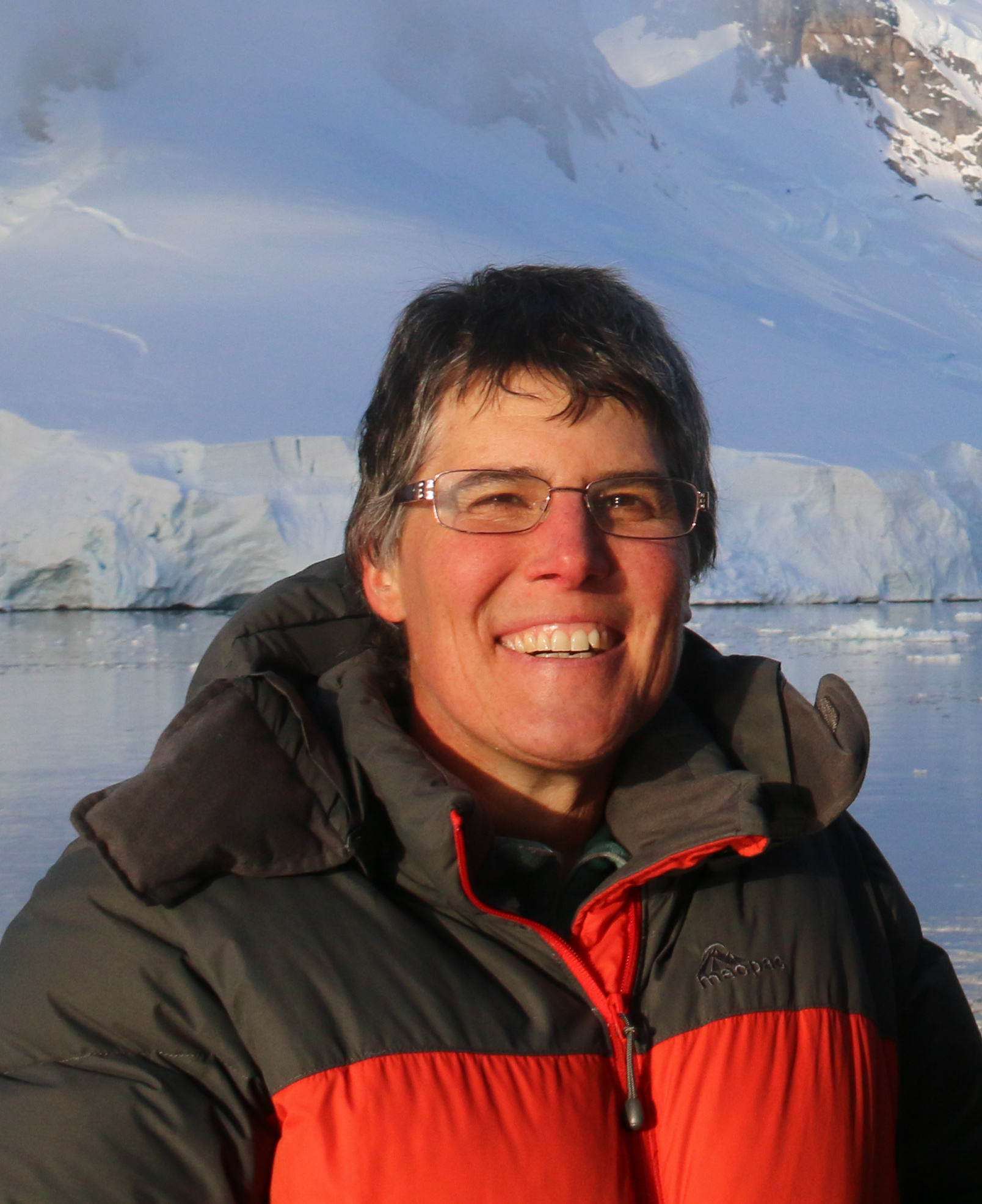Saturday 21 Nov (part 1)
Since one of the main distractions in my life involves electronic navigation and degrees of latitude and longitude (oh, and plastic boxes, but they’re just to provide additional motivation) it was only natural to make a pilgrimage to Greenwich.
Imagine my surprise, therefore, to discover, that I hit the magical E 000° 00.000 some 100m to the EAST of the prime meridian. So, in the first photo below, I am standing on an unmarked anonymous bit of park footpath, admiring the alignment of zeros … while everyone else is heading off to make a big fuss about another equally arbitrary but heavily marked and labelled line set in the concrete over at the Royal Observatory. I headed there myself, eventually, and that’s where I am in the remaining two photos (at N 51° 28.676 W 000° 00.090), with one foot in each hemisphere in the one that shows Hobart (Melbourne should feel slighted as it appears to be omitted from the list of cities shown 🙁 ).
Of course the Prime Meridian itself is quite arbitrary: it could have been put anywhere, and, indeed, has had at least 4 different locations at Greenwich. When the WGS84 system was set up to coordinatise the earth using satellites, the resulting 0th meridian ended up being quite a distance from its more famous counterpart (which was already “out” even before the WGS84 system came into being anyway).



 There are also many telescopes at the Observatory (which would be of little use now with London’s light pollution). It was interesting to read the story of Flamsteed, the first Astronomer Royal, who made a painstakingly accurate almanac of the stars, only he was not producing it fast enough for Newton who, with Halley, wanted the data in order to confirm some theories. Newton published them without Flamsteed’s permission, and Flamsteed managed to buy nearly all the copies and ceremonially burned them outside the observatory. Ah, the perils of research!
There are also many telescopes at the Observatory (which would be of little use now with London’s light pollution). It was interesting to read the story of Flamsteed, the first Astronomer Royal, who made a painstakingly accurate almanac of the stars, only he was not producing it fast enough for Newton who, with Halley, wanted the data in order to confirm some theories. Newton published them without Flamsteed’s permission, and Flamsteed managed to buy nearly all the copies and ceremonially burned them outside the observatory. Ah, the perils of research!
The other highlight of my visit was to see Harrison’s longitude clocks. In fact, there are many clocks in the collection, but these are the most famous. Harrison’s clocks were built to deal with the fact that satellite navigation did not exist back in the 1750s and so sailors had only a limited idea of where they were, especially with regard to longitude. This meant that they tended to crash into things, which was unpleasant, inconvenient and damp (not to mention occasionally fatal). However, since time-of-day and longitude are related, then having an accurate clock aboard ship would solve the problem.
 John Harrison was a clockmaker who attempted to construct such an accurate machine, starting with what were kind of like big table clocks, only even fancier (they are, truly, magnificent works of engineering and art). His first three clocks, including the one now known as H3 and shown above right, have been restored (a story in itself) and are currently working and keeping good time.
John Harrison was a clockmaker who attempted to construct such an accurate machine, starting with what were kind of like big table clocks, only even fancier (they are, truly, magnificent works of engineering and art). His first three clocks, including the one now known as H3 and shown above right, have been restored (a story in itself) and are currently working and keeping good time.
The remarkable thing, after seeing H3, is to move to the next display cabinet and see H4 (shown to the right). It is of a completely different design, like an overgrown pocket watch … although at nearly 1.5kg in weight, this implies a very large pocket and rather robust waistcoat construction. It is not running, because it requires lubrication and is more susceptible to wearing out. Captain Cook took a copy of it on his Pacific travels and was very pleased with its performance and the security it gave him in navigating; it lost only 5 seconds of time in two months.
It was a miracle that Harrison saw his genius rewarded, because he had to live to be 80 before the Board of Longitude finally acknowledged that he deserved their prize (he died at 83) .
The photo below shows part of London from the Royal Observatory at Greenwich.

 Helen Chick
Helen Chick
I saw his life story on ABC…what an amazing guy this John Harrison was..Took 1/2 of his life to perfect his clock…could you bring one back with you?
I loved Greenwich too and went there about 3 times. Did you walk through the tunnel under the Thames to get there? Creepy, with water seeping down the white tiled walls. Bit like being in a cistern. I didn’t know anything about Harrison’s clocks either, although I’ve since read Dava Sobel’s book Longitude which made you realise just what a battle he had to get recognition for what he’d done.